Studio Mixing Console
Whether it is home studios, project studios or any other studio, Mixing Consoles are an integral part of modern recording Studios. Mixing Consoles are used for applications such as broadcasting, recording and post-production for creating and mixing clean tracks. In this issue. PT is giving you a list of new studio mixing consoles, that have become a favourite of many sound designers.
Avid - Pro Tools Carbon
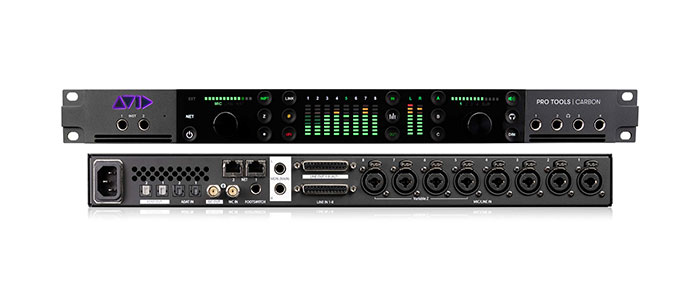
For artists, bands, and producers, Pro Tools | Carbon is a new breed of audio interface—built to capture brilliance. It’s a hybrid audio production system that features incredible sound quality and combines the power of the native CPU with onboard HDX DSP acceleration.
Main Features include:
- Achieve maximum Pro Tools performance with a hybrid system that harnesses onboard HDX DSP and native CPU power.
- Record flawlessly through AAX DSP plugins in real time, enabling to create polished cue mixes and track with zero audible latency.
- Toggle any track from native to DSP processing mode, freeing up the CPU cores to handle virtual instruments and more creative mixing.
- Capture every performance detail with up to 32-bit/192 kHz audio conversion, double precision clocking, and the most transparent mic preamp design ever.
- Create, record, edit, and mix professional-quality music with Pro Tools, thousands of instrument sounds, and studio-staple effects and sound processors.
- Expand the sonic possibilities with a special pack of premium plugins from Arturia McDSP, Plugin Alliance, UVI, Native Instruments, and more.
- Get all the I/O needs to record an entire band, with 25 x 34 simultaneous channels, including four headphone outs.
- Optimize or change up the tone of the mics, guitars, and basses with Variable Z inputs.
Technical Specification:
INPUTS
- Combo mic/line inputs: 8 balanced XLR/TRS with Variable Z (impedance) on inputs 5–8
- DB25 line inputs: 8 balanced via 25-pin D-sub
- Instrument (Variable Z) inputs: 2 unbalanced ¼-inch TS
- Digital inputs: ADAT: 16 channels @ 44.1–96 kHz; ADAT: 8 channels @ 176.4–192 kHz
A/D CONVERSION
- Mic preamps: Dynamic Range: 126 dB (A-weighted); THD+N: -105 dB (0.00056%); Frequency Response: 20 Hz–20 kHz, ±0.1 dB; EIN: -129 dB (A-weighted)
- Line inputs: Dynamic Range: 125 dB (A-weighted); THD+N: -103 dB (0.0007%); Frequency Response: 20 Hz–20 kHz, ±0.1 dB
- Line inputs (true bypass): Dynamic Range: 126 dB (A-weighted); THD+N: -114 dB (0.0002%); Frequency Response: 20 Hz–20 kHz, ±0.1 dB
- Instrument inputs: Dynamic Range: 125 dB (A-weighted); THD+N: -103 dB (0.0007%); Frequency Response: 20 Hz–20 kHz, ±0.1 dB
OUTPUTS
- DB25 line outputs: 8 balanced via 25-pin D-sub
- Monitor outputs: 2 balanced ¼-inch TRS
- Headphone outputs: 4 stereo ¼-inch TRS
- Digital outputs : ADAT: 16 channels @ 44.1–96 kHz; ADAT: 8 channels @ 176.4–192 kHz
D/A CONVERSION
- Line outputs: Dynamic Range: 120 dB (A-weighted); THD+N: -110 dB (0.0003%); Frequency Response: 20 Hz–20 kHz, ±0.1 dB
- Monitor outputs: Dynamic Range: 120 dB (A-weighted); THD+N: -110 dB (0.0003%); Frequency Response: 20 Hz–20 kHz, ±0.1 dB
- Headphone outputs Power: 100 mW into 300 ohm; 200 mW into 32 ohm; Dynamic Range: 116 dB (A-weighted); THD+N (32 ohm): -87 dB (0.0045%); THD+N (300 ohm): -100 dB (0.001%); Frequency Response: 20 Hz–20 kHz, ±0.1 dB
DSP Acceleration
- HDX DSP: 8 HDX DSP processors (2.8 GHz aggregated processing)
Additional Specifications
- Supported sample rates: 44.1 kHz–192 kHz; 32-bit, 192 kHz max
- Host connection: Ethernet
- Power supply: Single (internal)
- Chassis: 1U 19-inch rack-mountable unit
AMS - Neve 8424
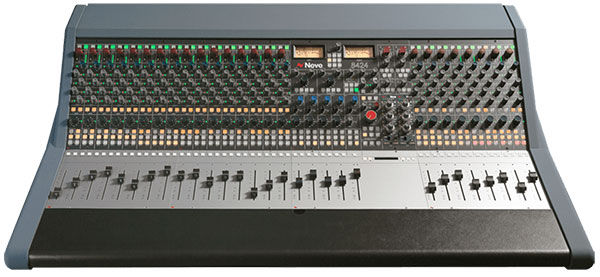
The 8424 console is designed to fit the needs of the modern hybrid studio where the speed of in-the-box workflow is enhanced with the ultimate sound quality of analogue outboard gear.
Main Features include:
- 24 Mono channels with source selections and 100mm faders
- 24 Channel Direct Outputs
- 4 Groups with 100mm faders
- 3 Mono Auxiliary sends
- 1 Stereo Cue send
- 2 Stereo Reverb Returns
- Marinair Transformer coupled Stereo Mix bus
- 2 1073 Microphone Pre-amplifiers
- 2 Hi-z DI inputs
- 2 500 Series Slots
- 4 Mono, 1 Stereo2-band shelving EQ
- 1 Stereo Width control
- 2 stereo External inputs
- 3 Loudspeaker Outputs
- 2 engineers’ headphone outputs
- 30 Balanced Inserts on Channels, Groups & Stereo mix
- 48 Input Capability
- 8 Stage LED Channel Input Meters
- Assignable Backlit VU meters
- Global channel A/B input switch
- Oscillator
- Smart routing
- Comprehensive connectivity on console rear
- Internal Power Supply
Technical Specification:
1073 to Channels 17 & 18
- Headroom: +27.7dBu @ 1kHz (<0.5% THD+N)
- Frequency Response: Typically +/-0.1dBu, 20Hz to 20kHz
- Distortion (THD+N): Typically 0.003% @ 1kHz (measured at +20dBu, 10Hz to 80kHz filter)
- Noise: <-87dBu(20Hz to 22kHz filter)
DI to Channels 19 & 20
- Headroom: >+27.7dBu @ 1kHz (<0.5% THD+N)
- Frequency Response: Typically +/-0.1dBu, 20Hz to 20kHz
- Distortion (THD+N): Typically 0.004% @ 1kHz (measured at +20dBu, 10Hz to 80kHz filter)
- Noise: <-87dBu(20Hz to 22kHz filter)
Control Room Output feed from Main Mix
- Headroom: >+26.5dBu @ 1kHz (<0.5% THD+N)
- Frequency Response: Typically +/-0.1dBu, 20Hz to 20kHz
- Distortion (THD+N): Typically 0.002% @ 1kHz (measured at +20dBu, 10Hz to 80kHz filter)
- Noise: <-87dBu (20Hz to 22kHz filter)
Crosstalk
- Inter-channel Crosstalk: <100dBu @ 1kHz
- Mix bus Crosstalk: <100dBu @ 1kHz
- Groupbus Crosstalk: <100dBu @ 1kHz
- Aux Mix bus Crosstalk: <100dBu @ 1kHz
Dimensions & Power Requirements
- Height - To top of LS Shelf (No Stand): 500mm/19.68 inches
- Height - To Top of LS Shelf (With Stand): 990mm/38.98 inches
- Width (24 Channel): 1190mm/46.85 inches
- Depth (24 Channel): 850mm/33.46inches
- Weight (no stand): 53kg
- Weight (with stand): 64kg
- Power factor: >0.87
- Voltage: Input Voltage Range 90-240v AC Only
Mackie - Onyx Mixer

Mackie Onyx Premium Analog Mixers with USB are the ultimate compact, affordable solution for live audio, home recording, and content creation. Packed with features including high-resolution 24-bit/96kHz recording, powerful DSP, and more.
Main Features include (Onyx24):
- 18 award-winning Onyx mic preamps provide up to 60dB of gain
- Premium analog circuitry delivers studio-quality sound and keeps noise to a minimum
- Analog/USB channel strips with flexible routing
- Legendary Perkins “British style” EQ with sweepable midrange offers classic sounds of the 60’s and 70’s
- Robust digital effect engine, including user-customizable reverbs, delays, and more, with a dedicated FX EQ
- High-resolution 96kHz / 24-bit multi-track recording to Mac/PC via USB
- Direct to SD card stereo recording and playback
- Channel-assignable 4-track USB return (2 stereo pairs)
- Easy navigation of FX parameters, onboard SD recording and playback
- Visually browse files on the SD card via the built-in display
- Dedicated physical buttons for Previous, Next, Record, and Play/Pause
- Store up to 6 user FX presets for easy recall
Technical Specifications (Onyx24):
Input Channels
- Mono Mic/Line - 14
- Mic/Stereo Line - 4
- Stereo Line – 1
- Mic Preamp Type: Onyx Mic Pre w/ up to 60dB of gain
- 48v Phantom Power: Global, switchable
- 100Hz Channel Low Cut: Switchable per channel
- Channel EQ: Perkins “British style” 3-band EQ with sweepable midrange and On/Oswitch Channel Inserts: Ch. 11 - 14
- Aux Sends: 2 + FX Send
- Bluetooth and Stereo 1/8”: Ch. 23/24
- Main Outputs: L/R TRS and XLR
- Main Meters: 12-Segment LED
- Channel Solo: AFL / PFL
- Internal FX: Adjustable Delay, Reverb, Chorus, and more Built-In Display: Full-Color Display and Single-Knob Interface. Adjust FX parameters, recall presets, manage and play recordings/music
- USB Recording: 96 kHz / 24-Bit 24×4 on Mac/PC
- Weight: 21.5 lb / 9.7 kg
- Dimensions (L × W × H): 25.2 × 14 × 5.4 in/639 × 356 × 136 mm
- Power Supply: Internal Universal 100 – 240 VAC
State Solid Logic - Origin
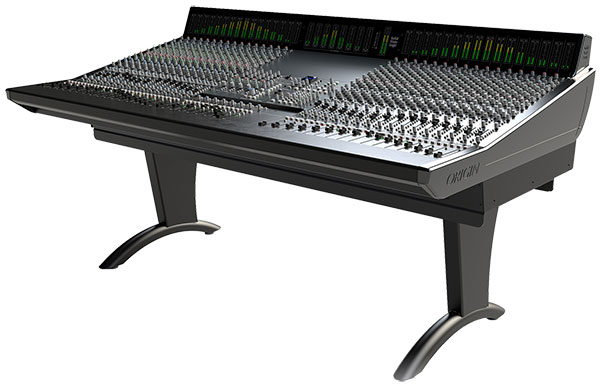
ORIGIN has a traditional analogue studio workflow while providing a modern DAW-driven ‘hybrid’ production studio. Its classic design looks back to the origin of in-line consoles for signal flow inspiration, incorporating cutting- edge analogue developments to deliver a unique sonic signature that’s still unmistakably SSL.
Main Features include:
- SSL Bus Compressor - Offering new compression ratios, insert return and built-in side chain filter.
- Bus Trim Masters and Routing - Central track bus routing matrix, featuring sixteen +/- 10dB Trims for the track buses, with a routing assign switches for each bus.
- Auto Sleep - Auto Sleep mode enables automatic detection of prolonged inactivity to put the console in stand-by, reducing power consumption.
- Solo Master Section - Solo controls provide Solo-In-Front with Mix balance, Solo-In-Place for Large, Small & Group faders and PFL options. Solo Level, Solo Clear and Red Light Switch complete options.
- Mix Bus - The mix bus features a high-quality 100mm fader, with fully balanced switched Insert for external bus processing.
- Monitoring - The monitoring section features independent Trims for Alternate Monitors 1 & 2, variable DIM level, MONO plus Left & Right MUTES and øL polarity switch. Returns - Four Stereo Return Inputs enable ORIGIN to route to Mix and Track Buses with level controlled feeds to Stereo Foldback Outputs A & B.
Technical Specifications :
- Gain: Mic Amp Gain Variable from +5 dB to +70 dB; Line Amp Gain Variable from -10 dB to +55 dB
- Input Impedance: 1.4 kΩ
- Output Headroom: >+26.5 dBu at onset of clipping
- Frequency Response: 20 Hz to 20 kHz/ +0/-0.02 dB
- THD + Noise: (-10 dBu applied, +30 dB gain) @ 1 kHz/<0.004% at 1 kHz (20 Hz to 20 kHz); (-10 dBu applied, +30 dB gain) @ 10 kHz/ <0.018% at 10 kHz (20 Hz to 40 kHz)
Crosstalk
- Channel Muting: 20 Hz to 20 kHz <-100 dB
- Maximum Fader Attenuation: 20 Hz to 20 kHz <-89 dB Pan pot Isolation: 20 Hz to 20 kHz <-55 dB
- Routing Channel to Main Mix: <-94 dB from 20 Hz to 20 kHz
- Mic Input: -50 dBu applied to Mic Input at maximum gain, measured at Direct Output, Monitor path selected/<-95 dB
PreSonus - StudioLive AR16c
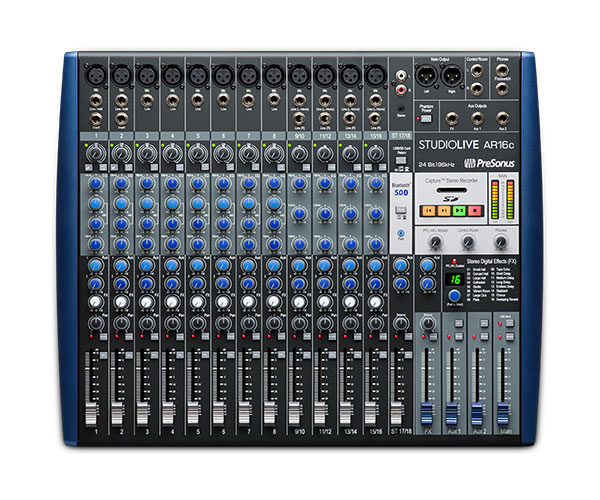
The StudioLive AR16c audio interface and analog mixer is tightly integrated with state-of-the-art recording software to help realize the creative vision. Record multitrack live performances with one click thanks to PreSonus’ Capture live-recording software.
Main Features include:
Recording
- 18x4 24-bit/96 kHz, USB 2.0 (over USB-C connection) audio recording interface
- Record every channel plus the main mix
- 2x2 SD recorder to capture the main mix
- Supports SD and SDHD formats up to 32 GB
Mixing
- 18-channel analog mixer
- 12 balanced microphone inputs with XMAX mic preamps
- 2 insert points
- 2 instrument/line inputs
- 16 balanced line level inputs:
- 8 mono
- 4 stereo pairs
- Stereo Super Channel (Ch. 17/18) with Bluetooth 5.0 input, RCA inputs, 1/8-inch stereo input, and switchable SD/USB stereo playback
- 8 mono and 4 stereo channels, each with level knob, pan, mute, PFL solo, highpass filter, and 3-band semi-parametric EQ
- 2 monitor buses with dedicated channel sends, AFL solo, and balanced TRS output
- L/R Control Room outputs with level control
- Headphone output with level control
Signal Processing
- Highpass filter on every channel
- 3-band quasi-parametric EQ with sweepable mid-band on each mono channel
- 3-band semi-parametric EQ on each stereo channel
- Stereo effects processor with 16 presets, dedicated send and return, and bypass footswitch jack
- Mic/line boost on stereo channels for low-level input sources and consumer devices
Included Software
- Capture live multitrack recording software
- Studio One Artist recording and production software (DAW)
- Studio Magic plug-in suite
Power
- Internal power supply
- Standard IEC power connector
Physical
- Sturdy metal construction
- 60 mm faders
- Rackmount kit included
Technical Specifications:
Microphone Preamp
- Type: XLR Female, Class A XMAX
- Maximum Input level (unity gain): +9 dBu ±1.0 dB
- Gain Control Range: 43 dB (+12 to +55 dB)
- Frequency Response to Analog Outputs: 20 Hz to 20 kHz, +0.5/-1.5 dB
- Frequency Response to USB (Direct): 20 Hz to 20 kHz, +0.5/- 1.5 dB
- S/N Ratio to Outputs (+4 dBu): 94 dB
- THD+N (min. gain, A-wtd): < 0.01%
- Input Impedance: 1 kΩ
- EIN (+55 dB gain, 150Ω input, 20 Hz-22 kHz, A-wtd): Mono Channels: < 128 dBu
- Common Mode Rejection Ratio (1 kHz, +55 dB gain): 65 dB
- Phantom Power: +48V, ±3V, Global
Line Inputs
- Type: ¼” TRS Female, Balanced
- Maximum Input Level (min. gain, 1 kHz@0.5% THD+N): +26 dBu ±1.0 dB
- Gain Control Range: Mono Channels: 40 dB, ±1 dB (-5 to +35 dB); Stereo Channels: 0 dB or +10 dB (+10 dB Boost)
- Frequency Response to Analog Outputs: 20 Hz to 20 kHz, +0.5/-1.5 dB
- Frequency Response to USB (Direct): 20 Hz to 20 kHz, +0.5/-1.5 dB
- S/N Ratio to Analog Outputs (+4 dBu): 85 dB
- THD+N (1 kHz, -1 dBFS, A-wtd): < 0.01%
- Input Impedance (Balanced): 10 kΩ
Main, Control Room, Monitor, and FX Outputs
- Type (Main Outputs): XLR Male, Impedance Balanced
- Type (Control Room, Monitor, FX Outputs): ¼” TRS Female, Balanced
- Rated Output Level (Main Outputs): +24 dBu, ±1.0 dB
- Rated Outputs Level (Control Room, Monitor, FX Outputs): +18 dBu
- Frequency Response: 20 Hz to 20 kHz, +0.5/-1.5 dB
- Dynamic Range (A-wtd): > 108 dB
- THD+N (Bandwidth 20 Hz - 20 kHz, -1 dBFS, unwtd): < 0.01%
- Output Impedance: 100 Ω
Physical
- Height: 3.5” (89 mm)
- Width (Chassis only): 18.9” (480 mm)
- Depth: 15.6” (397 mm)
- Weight: 14.1 lbs (6.4 kg)
Studiomaster Professional - D.Mix 20
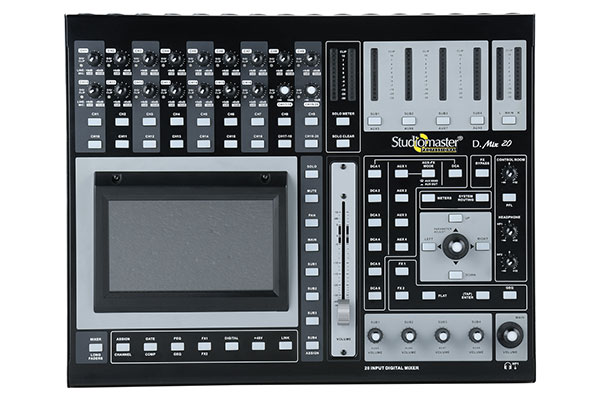
Studiomaster Professional brings the D.Mix 20 - a 20 channel digital mixer that combines the best of what an LCD touchscreen can offer with an intuitive interface for speed and precision in live mixing scenarios. While the console is digital, using the unit is as simple as an analogue one, making the learning curve remarkably quick.
Main Features include:
- 16 mono Input channels with assignable controls.
- 2 Stereo input channels.
- Full duplex USB port for reproduction of digital audio data from a PC & recording mixing onto a PC.
- 4 Aux Send outs & 4 Subgroup outs or 8 Aux outputs.
- 100mm motor-driven fader.
- User definable presets.
- LCD touch screen for settings, routing and navigation.
- 8 Channels Inserts.
- 1 USB audio channels.
- 2 integrated DSP’s with EQ, Noise Gate, Compressor / Limiter & Delay.
- 6 DCA groups.
- 24 bits/48kHz sampling rate.
- XLR & Jack Main outputs & Stereo Control Room output.
Technical Specifications:
- Gain (Mic/Line/Stereo Line): 50dB / 50 dB
- Max Gain (Mic/Line): 70dB / 70 dB
- Mic (Gain Min/Gain Max): 0 dBu / -50 dBu
- Line (Gain Min /Gain Max): +8 dBu / -40 dBu
- Mic Input: 5K Balanced
- Line input: 19K Unbalanced
- Main Output level (Nominal / Max): 0 dBu (0.775 V RMS) / +20 dBu (8V RMS)
- Main Output Impedance: 120 Ω
- Frequency Response: 20Hz to 20KHz (+0dB ± 1.5dB)
- Total Harmonic Distortion: <0.05%
- Signal to Noise Ratio: 85dB
- Mono Mic (Treble/Mid with Sweep/Bass): ±24dB (21 Hz – 19.2 KHZ)
- Stereo Line (Treble/Mid-Hi/Mid-low/Bass): ±24dB (21 Hz – 19.2 KHZ)
- EFX: 32 – Bit EFX Processor
- Phantom Supply: +48V
- Dimensions (W x D x H) mm: 445 x 355 x 140
- Net Weight (Kgs.): 7.25